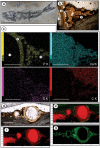Deciphering pyritization-kerogenization gradient for fish soft-tissue preservation
- PMID: 28469235
- PMCID: PMC5431149
- DOI: 10.1038/s41598-017-01563-0
Deciphering pyritization-kerogenization gradient for fish soft-tissue preservation
Abstract
Soft-tissue preservation provides palaeobiological information that is otherwise lost during fossilization. In Brazil, the Early Cretaceous Santana Formation contains fish with integument, muscles, connective tissues, and eyes that are still preserved. Our study revealed that soft-tissues were pyritized or kerogenized in different microfacies, which yielded distinct preservation fidelities. Indeed, new data provided the first record of pyritized vertebrate muscles and eyes. We propose that the different taphonomic pathways were controlled by distinct sedimentation rates in two different microfacies. Through this process, carcasses deposited in each of these microfacies underwent different residence times in sulphate-reduction and methanogenesis zones, thus yielding pyritized or kerogenized soft-tissues, and a similar process has previously been suggested in studies of a late Ediacaran lagerstätte.
Conflict of interest statement
The authors declare that they have no competing interests.
Figures







Similar articles
-
A unifying model for Neoproterozoic-Palaeozoic exceptional fossil preservation through pyritization and carbonaceous compression.Nat Commun. 2014 Dec 17;5:5754. doi: 10.1038/ncomms6754. Nat Commun. 2014. PMID: 25517864
-
Pyrite morphology and sulfur isotopes refine taphonomic models for the 2.1 Ga Francevillian biota, Gabon.Sci Rep. 2025 Jun 5;15(1):19790. doi: 10.1038/s41598-025-04512-4. Sci Rep. 2025. PMID: 40473672 Free PMC article.
-
Double fossilization in eukaryotic microorganisms from Lower Cretaceous amber.BMC Biol. 2009 Feb 20;7:9. doi: 10.1186/1741-7007-7-9. BMC Biol. 2009. PMID: 19232082 Free PMC article.
-
Soft-Bodied Fossils Are Not Simply Rotten Carcasses - Toward a Holistic Understanding of Exceptional Fossil Preservation: Exceptional Fossil Preservation Is Complex and Involves the Interplay of Numerous Biological and Geological Processes.Bioessays. 2018 Jan;40(1). doi: 10.1002/bies.201700167. Epub 2017 Nov 29. Bioessays. 2018. PMID: 29193177 Review.
-
'Fish' (Actinopterygii and Elasmobranchii) diversification patterns through deep time.Biol Rev Camb Philos Soc. 2016 Nov;91(4):950-981. doi: 10.1111/brv.12203. Epub 2015 Jun 23. Biol Rev Camb Philos Soc. 2016. PMID: 26105527 Review.
Cited by
-
Diagenetic processes in Quaternary fossil bones from tropical limestone caves.Sci Rep. 2020 Dec 8;10(1):21425. doi: 10.1038/s41598-020-78482-0. Sci Rep. 2020. PMID: 33293631 Free PMC article.
-
The Upper Triassic Polzberg palaeobiota from a marine Konservat-Lagerstätte deposited during the Carnian Pluvial Episode in Austria.Sci Rep. 2021 Aug 17;11(1):16644. doi: 10.1038/s41598-021-96052-w. Sci Rep. 2021. PMID: 34404880 Free PMC article.
-
Exceptionally preserved 'skin' in an Early Cretaceous fish from Colombia.PeerJ. 2020 Jul 8;8:e9479. doi: 10.7717/peerj.9479. eCollection 2020. PeerJ. 2020. PMID: 32714661 Free PMC article.
-
Ediacaran Corumbella has a cataphract calcareous skeleton with controlled biomineralization.iScience. 2022 Nov 25;25(12):105676. doi: 10.1016/j.isci.2022.105676. eCollection 2022 Dec 22. iScience. 2022. PMID: 36561886 Free PMC article.
-
Ediacaran metazoan reveals lophotrochozoan affinity and deepens root of Cambrian Explosion.Sci Adv. 2021 Jan 1;7(1):eabf2933. doi: 10.1126/sciadv.abf2933. Print 2021 Jan. Sci Adv. 2021. PMID: 33523867 Free PMC article.
References
-
- Seilacher A, Reif W-E, Westphal F. Sedimentological, ecological and temporal patterns of fossil lagerstätten. Philos. Trans. R. Soc. Lond. B Biol. Sci. 1985;311:5–23. doi: 10.1098/rstb.1985.0134. - DOI
-
- Martill, D. M., Bechly, G. & Loveridge, R. The Crato Fossil Beds of Brazil: Window To An Ancient World (Cambridge University Press, New York, 2007).
-
- Pinheiro FL, Horn BLD, Schultz CL, de Andrade JAFG, Sucerquia PA. Fossilized bacteria in a Cretaceous pterosaur headcrest. Lethaia. 2012;45:495–499. doi: 10.1111/j.1502-3931.2012.00309.x. - DOI
-
- Fielding S, Martill DM, Naish D. Solnhofen-style soft-tissue preservation in a new species of turtle from the Crato Formation (early Cretaceous, Aptian) of north-east Brazil. Palaeontology. 2005;48:1301–1310. doi: 10.1111/j.1475-4983.2005.00508.x. - DOI
Publication types
MeSH terms
Substances
LinkOut - more resources
Full Text Sources
Other Literature Sources
Medical

